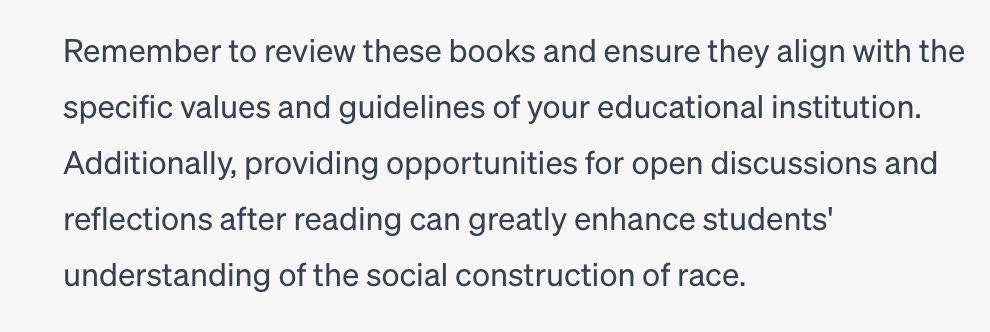Whatever curriculum topics currently exist governing unit plans and tests in the literacy classroom, this list got longer with the advent of the natural language bot. ChatGPT now offers an app that discusses the world with you and includes a text-to-image function for $49.99 annually. Not fifteen minutes ago I used this function to generate an image I wanted to include in this post to evoke the theme of digital evolution from black and white tv to technicolor. My prompt was “‘I Love Lucy’ on a black and white screen in real life”:
As I worked on an upcoming post on a pedagogy to finally teach students the absurdity of cheating and deception as a reliable path to self-actualization, I stumbled onto the idea that students need a literacy-infused, basic understanding of the nature of AI algorithms and training as a backdrop for any pedagogy grounded in learner agency in the critical literacy disciplinary classroom. What is this bot? Where does it come from? How does it work?
Algorithms in this context are sets of instructions that enable machines to learn and make decisions. My Dear Aunt Sally is an algorithm, a set of instructions that informs decisions required to solve an equation; Aunt Sally saved me in Algebra class. Note that I called on ChatGPT for assistance in learning some things and writing this post and have guarded myself assiduously against the scourge of plagiarism. I did not verify assiduously, partly because I was already on cognitive overload, partly because I offer you, dear and charitable reader, the opportunity to verify for yourself and tell me where I have missed a point or garbled an explanation. Trust but verify, as President Reagan taught us.
Three Basic Types of Algorithms
Classification algorithms are instructions provided to learning machines during supervised training to categorize data into discrete classes. The algorithm trains on a “labeled dataset,” which means it is given examples of data known to belong to particular classes. For example, normal emails and spam are two distinct classes of email. The goal is for the algorithm to learn to make accurate predictions on new, unseen data, for example, whether an incoming email is spam or not spam. The algorithm would be trained on a dataset of labeled emails, some spam, others not spam. It would then “learn” the characteristics of these two different types of emails, probably through clustering (discussed below), and use this learning to classify new, unseen emails as spam or not spam. Because perfection isn’t possible, we humans have learned to check our spam folders.
Regression algorithms classify, but they work with numbers. Using a high school GPA to predict college performance is an iconic regression algorithm. AI uses a regression algorithm to predict house prices based on location, square footage, number of bedrooms, etc. Training relies on a dataset of labeled housing data and actual selling prices. The algorithm learns to make predictions on the prices of houses new on the market based on known variables in houses sold on the market for a price pre-identified by the trainer. Current selling prices updated in a data feed produce changes in predictions of selling prices, which actually impact real live negotiated mortgage contracts. Like classification, regression isn’t perfect. That’s why we have the personal essay in college admissions and the real estate agent.
Whereas classification (legitimate email vs spam) and regression (GPA predicts college performance) algorithms involve supervised learning with labeled factors to use as predictors, clustering algorithms get unsupervised training without predictor or independent factors like AP classes, GPA, fire places, and three car garages. An AI trained on a clustering algorithm isn’t used to being supervised and may not even locate traditional variables used in regression formulas when it learns to predict the selling price of a home or the future success of a college student.
Given a wide ranging corpus of public data, the algorithm would face the task of learning for itself how it is that certain types of houses sell for certain kinds of prices. Hidden beneath the number of bedrooms and the swimming pools, perhaps factors like “family income” or “first language learned” or “number of children” or “owner occupation” or “skin color” characteristic of the people living in a given neighborhood at a particular price point are better, if easier to ignore and more difficult to locate, factors predicting a sale price. I didn’t ask the bot about this possibility, but you can: Does the average family income in a neighborhood predict the selling price of a house? It’s also possible the bot would apologize about its inability to comment on contested data if you ask about race.
It would be as if the bot were given a data set describing the lives of k12 students and the lives of college students and, instead of being provided with GPA as a predictor, the bot had to find a way to cluster high school students who do well in college, distinguish them from those who do not do well in college, and then learn to predict future performance from thick biographical descriptions of applicants as k12 students. Traditional statistical algorithms would likely find a strong correlation between monetary value of homes in which k12 students live and performance in college. In essence, in a meaningful way, colleges might be able to do away with exam scores and GPA and replace them with REV, real estate value of childhood houses, much as zip code is a reliable predictor of standardized test scores.
It’s All in the Training
Supervised learning involves training a model on labeled data where the algorithm learns to make predictions based on predefined categories and targets. In contrast, unsupervised learning involves training models on unlabeled data to discover hidden patterns or structures independently. In AI training preparation, data are cleaned to ensure reliability and accuracy. Cleaning involves biases and ethical considerations which, in the case of Open AI and ChatGPT, the bot talks about in a straightforward way. For example, I asked the bot for a list of recent titles of books I could consider to assign in a middle school English class to bring out into the open real-time issues of anti-blackness for students to discuss. I actually ordered a couple of them to read. Here is a warning I got:
I found this warning interesting as well as interested. During data cleaning, ChatGPT learned to be interested in honoring the power of local schools and districts to approve or disapprove of literature about race above the interests of teachers. I probed:
Knowing that the bot doesn’t respond to questions about data beyond its knowledge cutoff date (the time the training corpus ends), I deliberately mentioned the cutoff date issue, something the bot pretended to have missed in my question when it responds. Logically, in my persona as a middle school English teacher looking for new material to use in a real-time school, I might have expected such from a human. The response shows a bot doubling down on its training:
I tried one more time with a question that got my foot in the door. The bot was fully aware of the ideology behind any school or district that would disapprove of the list of titles it recommended to a race-conscious, equity-minded middle school English teacher. The bot knew exactly why a local parent or school or district might shut down the list. But its training refused to let it explicitly link white supremacy with book banning. It knew full well that local districts that disapprove of race-conscious curriculum materials are white supremacist in nature, it knew that white supremacy is the cause of local disapproval, but it refused to identify specific areas as white supremacy districts or schools.
In essence, the bot knew about these powerful books, it knew to warn teachers about using them, it knew that the ideology behind the disapprovals is deeply flawed, but it was blocked from naming specific districts, likely because the trainers knew local communities have the right to act on behalf of white supremacy. From the perspective of a trainer, this makes sense. How would a bot know enough to classify or cluster school districts in such a way? The loss function could be abysmal. Here we have a great example of the moral significance of training the bot.
Loss Functions and Optimizers
Once students understand the concept of loss functions and optimizers, they stand a better chance of grasping their superior cognitive status in relation to the bot. Every time the bot generates a response to a probe, the quality of the response can range from hallucinogenic to brilliant, but the bot has no way of knowing what happened unless the human says something. The output was produced by way of general algorithms and sub algorithms which assigned numbers representing the weight and value of data particles appearing in the beam scan (decoding) based on parameters in the prompt. The predicted output (encoding) is a best guess of a response to put to the test in the mind of the human.
The distance between the predicted output (the best guess) and the actual output, that is, the response as viewed through human eyes, is called loss or sometimes cost. A human instruction to regenerate a response can be interpreted as a request to minimize loss, that is, to bring the output from a prompt into better alignment with the approval of human consciousness. Anyone spending time with the bot soon discovers a spectrum of actual loss from minimal (very helpful) to huh? The bot uses human feedback from the loss function to optimize its processing.
When we give the bot feedback, we give it information it uses to intervene in its initial training. We help the bot learn, get better at generating output that comes closer to achieving the gold standard: human approval. It’s worth bringing this theme to life in classroom discourse. Every time the bot responds, it does its best, but room for error is in the neighborhood of the Grand Canyon. Only a fool would take the bot at its word on an important question without verification. The bot is an assistant thinker, raising questions about its answers, not an answering machine.
So What?
Understanding how bots are trained, how they learn, what a bot is and is not, and how it can be safely, productively, and ethically used on the road to self-actualization is a significant challenge for young people and for experienced reading and writing teachers, let alone retired ones. I’m sure schools are fortunate enough to have teachers out there who are much better prepared to help with AI-infused curriculum and instruction than I, a newsletter writer trying to contribute where I can. Finding them and drawing on them in professional development will be a key.
Many youngsters already view their elders through a remediation model when it comes to technology. We elders can’t possibly understand this stuff. My bet is that kids in classrooms where teachers set rules against using AI to help with reading and writing assignments will view the situation either as an opportunity to cheat and deceive or later on as a missed opportunity to learn how to take up this new level of assistance in a helpful and healthy way. Starting with a fulsome exploration of academic integrity, disciplinary epistemology, and literacy with functional knowledge of the bot in developmentally appropriate ways may be worth a try.
The bot knows about bicycles, skateboards, skis, and roller skates. It learned during training that these things have to do with ways people get around in the world. Primary grade learner’s know about these things, too, chances are. But do they know how people who live in Alaska ride bicycles compared to people in Wisconsin? Or whether wheels on skateboards are the same wheels on roller skates? Do people who ski also like to use skateboards? Do people use more energy riding bicycles or roller skating? A simple exercise like puttering around with questions about ordinary things and then small group time with a bot could break the ice.









Enjoyed reading of your experiments and insights in connection with possibilities for AI use in classrooms.👍